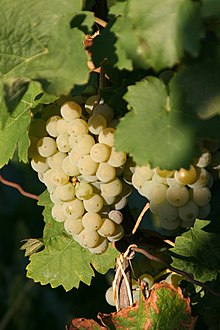Kerner (grape)
| Kerner | |
|---|---|
| Grape (Vitis) | |

Kerner grapes
|
|
| Color of berry skin | Blanc |
| Species | Vitis vinifera |
| Also called | Weißer Herold, Weinsberg S 25-30 |
| Origin | Lauffen, Germany |
| Notable regions | Germany |
The Kerner grape is an aromatic white grape variety. It was bred in 1929 by August Herold by crossing Trollinger (a red variety also known as Schiava grossa or Vernatsch) and Riesling. Herold was working at a plant breeding station in Lauffen in the Württemberg region of Germany. This station belonged to a state breeding institute headquartered in Weinsberg. It received varietal protection and was released for general cultivation in 1969.
Kerner has been named in honour of a poet and physician from Swabia, Justinus Kerner, whose works included songs and poetry on wine. Kerner lived from 1818 to his death in Weinsberg.
In 2006 Kerner was the 8th most planted variety in Germany with 4,004 hectares (9,890 acres) and 3.9% of the total vineyard surface. The trend since the mid-1990s is that German plantations of Kerner decrease, just as the case for all other "new breeds" of white varieties, such as Müller-Thurgau and Bacchus. German plantations of Kerner reached their highest point around 1990, with around 8,000 hectares (20,000 acres) and 7.5% of the total German vineyard surface. For a while around 1995 it was in fact the third most planted variety in Germany after Riesling and Müller-Thurgau.
Kerner is most commonly planted in the German regions of Palatinate, Rheinhessen, Mosel, and Württemberg, but it is also grown in Austria (Styria), Switzerland and the Italian province of South Tyrol. It was introduced into South Tyrol in the early 1970s and awarded Denominazione di origine controllata (DOC) status in 1993.
...
Wikipedia
